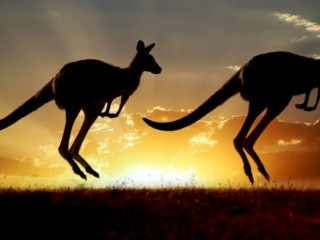 Kangaroo populations are bouncing back to concerning levels across many pastoral areas as a result of last summer’s big wet and lower harvesting rates due to the ongoing closure of the major Russian market for kangaroo meat.
Kangaroo populations are bouncing back to concerning levels across many pastoral areas as a result of last summer’s big wet and lower harvesting rates due to the ongoing closure of the major Russian market for kangaroo meat.
Anecdotal reports of large mobs of kangaroos chasing green pick along roadsides are becoming increasingly prevalent as hot and windy conditions continue to dry off standing paddock feed.
Graziers are concerned that if not addressed populations could soon explode to unsustainable levels that would lead to an ecological disaster and accelerate a return to drought in many areas.
The Queensland and New South Wales Governments are due to release the results of their latest official counts of kangaroo populations by November.
AgForce macropod committee spokesman and Quilpie grazier Stephen Tully said Queensland was currently carrying about 15 million kangaroos, but populations could easily double to 30m within the next two years.
When kangaroo numbers last reached 30 million in 2000, more than two thirds died of starvation in the ensuing two years of drought.
“Bear in mind there are only 18 million cattle and five million sheep in Queensland, so these numbers (15 million) are enormous on their own count,” Mr Tully said.
“We would expect numbers to be increasing by at least 5-7 million every year from here.
“So we are heading straight for another ecological disaster of seeing 20 odd million kangaroos die of starvation again, and it is completely able to be prevented.
“It is just that we don’t have the willingness to get something done about this industry so it can actually function in a flexible and professional way.”
Mr Tully wants Government management of the kangaroo industry reviewed and streamlined to remove onerous red tape and ad hoc weight restrictions and to allow harvesters and graziers to make best use of the commercial opportunity that booming kangaroo populations present.
He would like to see the Government consider a more simplified management system in which quota and permit restrictions are used to maintain a minium safety net of 8-10 million kangaroos, but restrictions and permit requirements removed when numbers exceed 15 million.
Mr Tully said rising kangaroo populations would have a significant impact on paddock feed reserves as they increased, particularly if the season continued to dry out.
“I think for most people they aren’t having a major impact yet, but there are always pockets where they are.”
Longreach kangaroo harvester and box operator Jeff Newton said kangaroo populations had the potential to increase extremely quickly because female kangaroos bred year around. “They always have three on the go, one at foot, one in the pouch and one on the way,” he said.
“If we get a reasonable season again they are going to explode.”
Mr Newton said the kangaroo meat industry had suffered since the Russian ban was imposed over a contamination issue more than two years ago, and many harvesters had either left or were leaving the industry.
“We staggered on for the best part of three years now and everyone has just had enough,” he said.
Shooters are currently receiving about 70c/kg carcase weight, down from $1.20/kg when the Russian market was at its peak. Those that had stuck with the industry were having to shoot more kangaroos to remain viable, which meant longer hours in the field and higher costs.
Traditionally shooters had a fallback market of shooting for skins but Mr Newton said that market was no longer viable after major manufacturers such as Adidas moved away from using kangaroo leather in response to public pressure from animal rights activists.
He said grazing pressure from kangaroos would build.
“There is so much bulk feed at the moment,” Mr Newton said. “Obviously they will be having an impact, it is a different story to when there is no grass at all, but there is still grass three foot high here.
“There is no protein in it and the roos just move to where the green feed is.”



HAVE YOUR SAY